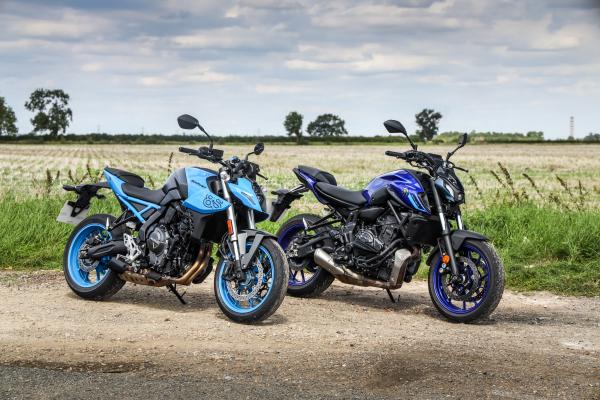
The MT-07 has been the king of the middleweight naked bikes for years, but with numerous new pretenders to the throne, including the Suzuki GSX-8S, is that still the case?
The middleweight naked market is looking hugely exciting these days. We’ve had a slew of new contenders appearing in the last few years, and they’re all aiming to do one thing - knock the long-standing middleweight king off its throne.
We’re talking about the Yamaha MT-07, which has been the go-to reasonably priced roadster ever since it was launched nearly 10 years ago. But it’s getting on a bit now, so how does it fare next to what might just be the best of the newbies, the Suzuki GSX-8S?
To find out, we rode the two back to back on the same roads and pored over the specsheets. Here’s how we got on:
Yamaha MT-07 technical specifications
The MT-07 has received two major updates over the years, but underneath, it is largely the same bike that Yamaha launched way back in 2014. It features a tubular frame and a double-sided swingarm, and a ‘CP2’ 689cc parallel twin.
The CP2 is widely used across Yamaha’s range of bikes including the R7, Tenere 700, Tracer 7 and XSR700 and XSR700 Tribute, as well as the Fantic Caballero 700. As is fast becoming the norm for parallel twins in middleweight bikes, it uses a 270-degree crankshaft. This offsets the firing order, giving the engine similar characteristics to a V-twin, but in a much more compact and less complex package. Here, it develops 73bhp at 8,500rpm and 49lb ft from 6,800rpm.
While it has a very common engine format, the MT-07 has something seen much less frequently these days - conventional (rather than upside-down) forks. The suspension comes from KYB, and is non-adjustable at the front, while the rear monoshock is preload adjustable.
The electronics package is disarmingly simple, comprising of the now-mandatory ABS, and…that’s your lot. No driving modes, no traction control, and although it’s pre-wired for a quickshifter that can be fitted at a dealer, it only works on the upshifts. For 2023 you do at least get a five-inch colour TFT with smartphone connectivity.
Yamaha MT-07: what it’s like to ride
In a word - firm. We aren’t the first people to moan about the MT-07’s harsh suspension characteristics, from bike publications to owners, and we certainly won’t be the last. The chassis is firm and lacks finesse, so on badly-surfaced B-roads - and let’s face it, that’s a lot of them - you do feel like you’re being bounced around, robbing confidence.
It also feels more cramped than the GSX-8S for a taller rider, not helped by the pegs being quite high and far back. An 815mm seat height means it’s plenty accessible for shorter folk, but however short or lanky you are, you’ll notice that the Yamaha feels more cheaply finished than the Suzuki. It’s not bad for the most part, although there’s quite a bit of lateral play in the throttle assembly, which does get annoying.
There’s some payback in the corners, where the MT-07 feels a little sharper than the 8S, and more willing to change direction. It might have helped that it was shod in Michelin Road 5 tyres, which we’d rate above the Dunlop Road Smart 2s on the Suzuki.
The MT claws back further ground thanks to its CP2 engine. Yes, it’s not as powerful as the twin in the 8S, nor as smooth, but it’s more characterful, making a better noise and feeling gutsier lower down. And if it matters to you, the MT-07 is much keener to lift its front wheel under throttle…
Riding around town, the MT-07’s engine isn’t quite as smooth as the GSX-8S lump, but there’s not much in it. The sharp action of the clutch lever takes some getting used to, though.
Suzuki GSX-8S technical specifications
The GSX-8S is based around an all-new tubular steel frame with a double-sided aluminium swing arm. The “all-new” bit is significant, as the GSX 8S is - believe it or not - the first completely fresh big bike from Suzuki since 1999. The motorcycle that arrived that year was none other than the SV650, for which the 8S can be thought of as an indirect replacement.
Into the frame goes - surprise surprise - a parallel twin with a 270-degree crankshaft. It gets bragging rights over the Yamaha CP2 lump in terms of both capacity and output, displacing 776cc and developing 82bhp at 9,000pm and 60lb ft of torque at 6,500rpm.
Further mirroring the Yamaha, the Suzuki gets KYB suspension front and rear, but with upside-down forks. Again, you don’t get any adjustment at the front, and only preload adjustment at the rear. For this kind of money, that’s to be expected.
Where the 8S starts to defy its modest price tag is in the electronics - there’s far more going on here than on the Yamaha. The Suzuki Drive Mode Selector (SDMS) features three settings - A for the sharpest throttle attitude, B to soften it off, and C for when it’s raining. There are three traction control modes that can be selected independently of the drive modes, or four if you include ‘off’.
As on the Yamaha, the ABS is of the simple variety (i.e. not anything fancy like cornering ABS), and as standard, you have a quickshifter which works for both the up and downshifts. The five-inch colour TFT matches the size of the MT-07’s, but it doesn’t come with Bluetooth connectivity.
Suzuki GSX-8S - what it’s like to ride
You only need to ride the GSX-8S a few hundred metres to discover it feels much more modern and grown-up than the MT-07. The far more sophisticated electronics offering certainly contributes to this, but that’s not all - it may also use KYB hardware for the suspension, but the Suzuki’s application of it feels far better sorted.
It’s still on the firmer side, but there’s more plushness aboard the 8S. It does a far better job of soaking up imperfections in the road surface, meaning you’re less wary about being ejected from the seat if the going gets a bit rough. The cockpit is roomier, and the peg position more comfortable. Everything feels just a bit better built, too.
Whether you’re bimbling about or twisting the throttle wide open, the new parallel twin impresses. Of all the current crop of 270-degree crank twins, it might just be the smoothest and makes a good noise, too. Combined with the standard-fit quick-shifter to effortlessly bang through the gears, it’s all but guaranteed to provide a good time.
At 202kg, it’s 18kg bulkier than the MT-07, but you don’t feel that difference in the saddle. What you do notice is a greater feeling of stability, which is largely down to the longer wheelbase. It makes the 8S easier to get on terms with, at the expense of feeling a little less edgy.
Suzuki GSX-8S vs Yamaha MT-07 vs Honda Hornet vs…
There’s no shortage of rivals for these two bikes - all the major brands are having a pop at this segment. The most obvious one trying to get a slice of the pie is the new Honda CB750 Hornet (pictured), which also uses a 270-degree parallel twin.
We’ve ridden it extensively, and reckon the suspension is much better sorted than the Yamaha MT-07’s, but it doesn’t feel quite as plush as the Suzuki GSX-8S. The latter is also noticeably smoother when riding at lower speeds/revs, and arguably looks better. The Hornet is comfortably the cheapest of the three at £6,995, though. Bargain.
It doesn’t have to be a twin, if you don't want - for this kind of money, the Triumph Trident looks extremely tempting. It has gorgeous retro looks, a 660cc inline-three that mixes mid-range clout with a fruity top-end rush, and really well-sorted TFT display. At the time of writing it comes in at £100 less than the Suzuki.
Second opinion: Toad’s take
I make no secrets about being a fan of the MT-07, in fact, I’m keen on the MT-09 and MT-10 too. But I’m also a realist, and while the CP2 engine is an absolute gem, there are other aspects of the bike that are beginning to show their age, especially the suspension. While the playful nature of the Yamaha is part of its appeal, an increase in composure, especially when braking and on poor road surfaces, would be welcome. It’s so nimble, changing direction with telepathic ease, if only it had a bit more finesse, it’d be the complete package.
Some may bemoan the MT-07 for its lack of technology, but I find its stripped-back electronics suite quite refreshing, and with no riding modes or traction control to fiddle with you can focus solely on the act of riding. Granted, there is an argument that having some safety systems and technology on a supposed starter bike is a good thing, and on the one hand, I agree. I also think there is something to be said for developing a rider’s own inbuilt traction control system - their right wrist!
Jumping from the Yamaha to the Suzuki it became immediately apparent that GSX-8S is a much more serious machine. The engine is smoother and more refined, as is the suspension, and both these factors make it a much quicker bike from A to B. It’s also got more power and torque than the Yamaha, although as with my point regarding the MT-07’s electronics, that’s both a good and bad thing. The GSX-8S seems less gutsy at the bottom of the rev range, and a more peaky than the Yamaha. That does mean you have to work the bike harder to get it into the fun zone, and by then you’re already going faster than you would be on the CP2 powered bike.
For me, though, the Yamaha will always be the bike I’d turn to when the sun was shining and a B-road was calling. It’s plenty quick enough for a spirited weekend ride out, and pretty much all of its problems drift away once you get going. I also think that as it’s such an important bike for the Iwata factory, it’ll be getting a much more significant update before too long.
Suzuki GSX-8S vs Yamaha MT-07: conclusions
By most measures, the Suzuki GSX-8S is a better bike than the Yamaha MT-07, which in comparison feels dated, cheaper, cramped, and harsher or poor road surfaces. The Suzuki easily justifies its higher price tag with better finishing and more tech.
The 8S is the easier bike to ride fast, and we reckon it’s the most beginner-friendly thanks to its riding modes, traction control and sense of stability. It’ll prove plenty enjoyable for more experienced riders, too, although some may prefer the more challenging, playful nature of the MT-07.
And so, while the MT-07 perhaps isn’t the king of the middleweight naked bikes like it once was, it does still have a place.
Suzuki GSX-8S vs Yamaha MT-07: head-to-head video
Suzuki GSX-8S vs Yamaha MT-07 specs
Suzuki GSX-8S | Yamaha MT-07 | |
Engine capacity | 776cc | 689cc |
Power | 82bhp at 8,500 rpm | 73bhp @ 8,750 rpm |
Torque | 60 lb-ft (78Nm) @ 6,800 rpm | 49 lb-ft (67Nm) @ 6,500 rpm |
Gearbox | Six-speed | Six-Speed |
Quckshifter | Yes | No (optional extra) |
Slipper clutch | Yes | No |
Weight | 202 kg (kerb) | 184 kg (wet) |
Seat height | 810mm | 805mm |
Fuel capacity | 14 litres | 14 litres |
Price | £7,999 (RRP) | £7,510 (RRP) |

